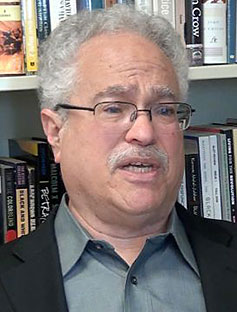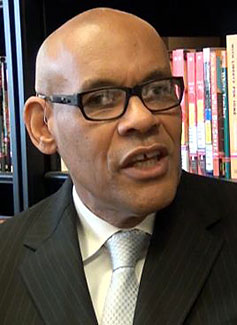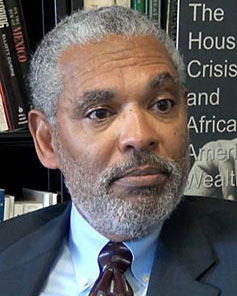
A Dream of Equality and Justice
When Martin Luther King Jr. stood on the steps of the Lincoln Memorial in August 1963 and uttered the words “I have a dream,” he spoke to a nation mired in bitter struggles over civil rights and social and economic injustice.
That speech, and his exhortation for a society that would judge his children not “by the color of their skin, but by the content of their character,” has become the most common representation of King as a symbol of the fight for racial equality. But, as scholars at UC Santa Barbara point out, to distinguish him by those words alone is to exclude his work as a human rights activist on a global scale and to overlook some of his greatest accomplishments.
A Revolution of Values
 “The gap between who Dr. King was and how he is remembered may be the widest in history.”
“The gap between who Dr. King was and how he is remembered may be the widest in history.”
George Lipsitz
professor of black studies
“Martin Luther King is America’s most widely recognized but least understood historical figure,” noted George Lipsitz, UCSB professor of black studies. “The gap between who Dr. King was and how he is remembered may be the widest in history.
“We know one sentence by Dr. King — of his wanting his children to be judged by the content of their character and not by the color of their skin,” Lipsitz continued, “but we don’t know the Dr. King who, three years later, told a crowd in Jackson, Mississippi, that ‘my dream has turned into a nightmare.’ Who would have thought the best way to suppress understanding of Dr. King would be to constantly quote one sentence of his and leave out the other 39 years of his thinking and acting, talking and preaching?”
We don’t know the Dr. King who, that same summer of 1966, took his crusade to the streets and suburbs of Chicago where he argued that fair housing — desegregating American neighborhoods — was the most important call of the civil rights movement, Lipsitz went on. And we forget that he was met with bricks and bottles. King was condemned even by many of his former allies for stirring up a neighborhood rather than extending justice to a people who had been unfairly kept out of housing they could afford to rent or buy.
“What my students and I always find most interesting is that in the very weeks before he was killed, Dr. King was marching side by side with sanitation workers in Memphis, and he said it’s a crime for people to live in an affluent country and make poverty wages,” Lipsitz said. “So to think that King was only about desegregating the U.S. that existed is not at all true. He was a prophetic voice who thought that on issues of the economy, education and war and peace, the country was headed in the wrong direction. And it needed what he called ‘a revolution of values.’”
A Transformative Figure
 “The world we live in now is the world created by Martin Luther King, and it’s so pervasive that we don’t know it.”
“The world we live in now is the world created by Martin Luther King, and it’s so pervasive that we don’t know it.”
Jeffrey Stewart
professor and chair of black studies
“Martin Luther King is the single most transformative American of the 20th century,” said Jeffrey Stewart, chair and professor of black studies at UCSB. “Probably the only person who comes close to that is Franklin Delano Roosevelt in the sense that the world after him was completely different from the world before him.
“FDR changed our understanding of the obligation of the government to its people,” Stewart continued, “and I think Martin Luther King changed our understanding of the obligation of America to African-Americans. The world we live in now is the world created by Martin Luther King, and it’s so pervasive that we don’t know it.”
According to Stewart, King also brought a level of reconciliation between whites and blacks — although not without its continuing challenges — and created the possibility for whites to acknowledge the wrongs done to blacks over the course of American history and to commit themselves to a better way of being. “Other people are very important as well — Malcolm X and Ella Baker were very much a part of that, too — but King had a large tent, so to speak,” Stewart said. “A lot of people who were standing on the sidelines and perhaps didn’t know where or how they entered into the discussion of civil rights were given permission by King to join in a movement for social justice that they might not have felt was open to them.”
 “If you think about how to address inequality, the dimension that’s missing today is the dimension he brought — mass mobilization.”
“If you think about how to address inequality, the dimension that’s missing today is the dimension he brought — mass mobilization.”
Melvin Oliver
executive dean of the College of Letters & Science
A key to King’s success was his ability to mobilize people in great numbers. He was a gifted strategist who motivated people to fight injustice. “If you think about how to address inequality, the dimension that’s missing today is the dimension he brought — mass mobilization,” noted Melvin Oliver, executive dean of the College of Letters & Science at UCSB. “We thought we had it with the anti-Wall Street movement, but we didn’t. And no matter how President Obama positions himself, he can’t get traction on this issue unless there’s mass mobilization behind it. That’s where King’s legacy informs what we should be thinking about and doing now.”
 “I think there are two ways people are arguing about King and presenting him today, and they both have a lot of truth about them, but the emphasis is different.”
“I think there are two ways people are arguing about King and presenting him today, and they both have a lot of truth about them, but the emphasis is different.”
Nelson Lichtenstein
MacArthur Foundation Chair in History
Major historical figures — Abraham Lincoln, John F. Kennedy and Nelson Mandela, for example — almost transcend reality and are reinterpreted over time, and King is no exception. “His meaning in American life is subject to debate, and sometimes that debate is subtle, and other times it’s very vociferous and pointed,” said Nelson Lichtenstein, the MacArthur Foundation Chair in History at UCSB and director of the campus’s Center for the Study of Work, Labor, and Democracy. “I think there are two ways people are arguing about King and presenting him today, and they both have a lot of truth about them, but the emphasis is different.”
In one view, conservatives perceive King purely as a civil rights leader who advocated a colorblind society in which everyone is equal. In that way, they interpret his “I Have a Dream” speech as an argument opposing affirmative action. If people should be judged by the content of their character and not the color of their skin, they argue, then affirmative action is a form of discrimination because it is, after all, based on skin color.
“The other view, which most historians adopt,” Lichtenstein said, “is that King is very much part of a social democratic, Rooseveltian, New Deal movement. The civil rights movement was a completion and fulfillment of some of the impulses that came out of the New Deal, the labor movement and a multicultural labor movement.”
Radical and Principled Thinker
Said Alice O’Connor, UCSB professor of history: “The thing historians have done most to revise this sort of popularized vision of King as a hero of civil rights, voting rights, et cetera, has been to emphasize his longstanding commitment to economic as well as political democracy.
 “His rootedness in Ghandian thought was not just about embracing the concept of nonviolence; it was part of a larger vision of solidarity with people who were racially and economically oppressed around the world.”
“His rootedness in Ghandian thought was not just about embracing the concept of nonviolence; it was part of a larger vision of solidarity with people who were racially and economically oppressed around the world.”
Alice O’Connor
professor of history
“At the same time,” O’Connor continued, “historians have looked back on King’s writings to see a longstanding commitment to a more social democratic vision of what the movement should aspire to, as opposed to a narrower emphasis on what the movement is about — achieving voting rights and abolishing Jim Crow segregation. The revised vision is that it was about a much more radical set of demands that pushed toward economic rights as well as political and civil rights.”
As King continued to push the movement forward, the focus of his advocacy shifted to a more global view. Historians argue that this more radical take on the world was not new to King, but demonstrated his willingness — his need — to voice his opposition to issues such as the Vietnam War.
“Again, that’s the more radical King,” said O’Connor. “One could argue that his feelings about the war — and war in general — were there all along. In terms of strategizing where the movement should go, he became increasingly more willing to speak out in a very forthright way, and earlier than a lot of other people, to say we cannot support this war; it is completely unjust in terms of everything the civil rights movement stands for.
“In that posture, he’s very much identifying in a more overt way with the global struggle,” O’Connor continued. “His rootedness in Ghandian thought was not just about embracing the concept of nonviolence, it was part of a larger vision of solidarity with people who were racially and economically oppressed around the world. So if he was translating that into an increasingly overt opposition to the war, it wasn’t something he suddenly embraced in a turn against the war. It was bringing out and cultivating elements of his thought that had been there all along.”
King is a challenging figure in many ways, according to Lipsitz, because he was both a radical thinker and a principled one. “He wasn’t just looking for an America with a few of its racial obstacles removed,” Lipsitz said. “He was looking for an America that would give people opportunities and chances. He was looking for an America where love had real meaning and was not just a slogan. And it’s hard for us to comprehend that, and hard for us to hear those words that he spoke about economic inequality, about war and peace, about housing segregation, about school and educational inequality.
“Those are vexing problems, and he has a lot to say about them,” he continued. “But they’re not things we seem capable of hearing.”
Poor People’s Campaign
In 1968, King continued his commitment to economic justice by organizing a movement called the Poor People’s Campaign. Supported by the Southern Christian Leadership Congress, the movement demanded economic and human rights for poor Americans of all races. “The Poor People’s Campaign is really important to understanding what King was all about,” said O’Connor.
The Poor People’s Campaign followed upon King’s experiences of massive resistance in cities like Chicago, and national alarm over uprisings in Detroit and Newark, as well as his unwavering support of the sanitation workers’ strike in Memphis. The strike was part of a militant labor movement at the time, and showed King increasingly redefining the civil rights movement as one for economic justice. The Poor People’s Campaign was built around the issues of poverty, labor exploitation, economic inequality and unbalanced wealth distribution to form a cross-race coalition of people who were economically oppressed. It included whites, blacks, Chicanos and Latinos and Native Americans.
“They used those issues to organize another March on Washington — the Poor People’s March on Washington,” said O’Connor. “We’re going to bring an agenda that will realize an economic bill of rights for poor people of all colors, one that recognizes that we are mutually oppressed by economic exploitation. That was the plan. But King was assassinated even as serious organizing was just getting underway.”
With King gone, debate began within the movement, particularly within the Southern Christian Leadership Conference, about whether to proceed. The decision was made to continue, and with figures such as Ralph Abernathy and Jesse Jackson in the lead, the Poor People’s March on Washington took place a little more than a month after King’s death.
“It was quite amazing,” O’Connor said. “People came from all over the country, often in Greyhound buses, cars and caravans. It was an impressive turnout of people. As they approached Washington, they staged a very theatrical approach and literally arrived on the Mall in something resembling a mule train.”
For weeks, they occupied a space on the Mall adjacent to the Lincoln Memorial and built a settlement they called Resurrection City. “They had places for worship, places for people to have common meals, they had places for town hall meetings,” said O’Connor. “A lot of this was forgotten before the Occupy movement, and even when the Occupy movement happened, very few people recognized that they were replicating a lot of the tactics used in Resurrection City.”
From their settlement, leaders would send out delegations of people to demonstrate in front of various agencies — Housing and Urban Development, the Department of Labor. They’d ask for meetings with officials, and sometimes their requests were granted. Otherwise they’d demonstrate outside the offices.
“It was nowhere near as resounding and triumphant as the March on Washington in 1963,” O’Connor noted. “It had a very mixed legacy. Some write about it as a disaster, some claim it had limited gains, and some write about it as a sign of the dissipation of the movement. The Poor People’s Movement was able to come away with some concessions, though nothing like an economic bill of rights or resounding victory. Still, I think it’s a really important part of King’s legacy that rarely gets recognized.”
Inspiring a New Generation
 “Now I think that rather than his message having failed or being incomplete, I think it’s really the failure of American society to truly embrace his message.”
“Now I think that rather than his message having failed or being incomplete, I think it’s really the failure of American society to truly embrace his message.”
Tiana Miller-Leonard
undergraduate majoring in history
Most students coming to UCSB are well acquainted with Martin Luther King, even if their knowledge narrowly confines him to the civil rights movement and to the “I Have a Dream” motif. “One of the things we try to do in the Black Studies department is to bring out those aspects of King that are not well known,” said Stewart.
Tiana Miller-Leonard’s studies led her to a fuller and broader understanding of King as a leader. “We’re still facing a lot of the same issues that he was facing,” said the history undergraduate. “Learning more about him, and reading more about him, I used to think maybe he was naïve. Maybe he didn’t have the right approach. But now I think that rather than his message having failed or being incomplete, I think it’s really the failure of American society to truly embrace his message. He really did understand what needs to be done, and we just need to keep listening to him.”
 “I feel like Martin Luther King’s impact on me was more about my own identity, and about me not just being a black woman, but me being more of a contributor to this world, to my school, to all aspects of my life.”
“I feel like Martin Luther King’s impact on me was more about my own identity, and about me not just being a black woman, but me being more of a contributor to this world, to my school, to all aspects of my life.”
Kashira Ayers
undergraduate majoring in communication and feminist studies
For Kashira Ayers, an undergraduate majoring in communication and feminist studies, learning more about King helped her learn more about herself. “Growing up in south central L.A., and being a black person and knowing that not too long ago there was segregation, and not too long ago people were criminalized for the color of their skin — and that still happens now — I feel like Martin Luther King’s impact on me was more about my own identity,” she said. “And about me being not just a black woman, but me being more of a contributor to the world, a contributor to this school, a contributor in all aspects of my life.
The Arc of History
It may be that King’s greatest legacy is one of persistence and resolve and an unwillingness to give up the fight. “I think maybe the most important thing is his belief — his faith — that the arc of history tends toward justice,” said Stewart. “We’ll have a lot of problems, we’ll have people opposing us, but the tendency of history is toward justice. So if we keep the faith and continue to struggle, a just world will win out over an unjust one, and I think that’s a very important message right now.”
“It’s a moral and political and intellectual obligation,” added Lipsitz, “and so we need to have an optimism of the will — there’s plenty of reasons for pessimism of the intellect. But, really, what matters most is not how we feel about the path that is ahead of us, but what we do in response to it.”



